At Mike Splane’s latest chess party, on Sunday, Richard Koepcke showed us a game that involved a “hanging pawns” formation in the center, where the owner of the hanging pawns did not play actively enough, let them get blockaded, and eventually lost.
Mike then got up and said he would like to show us a game that also featured hanging pawns, which shows the opposite side of the equation — what can happen when the pawns get mobile. About seven moves into the game, somebody asked him, “Who was your opponent?” He said, “Oh, some patzer named Igor Ivanov.”
I thought this was pretty amusing for two reasons. First, because I’ve just been reading all about Igor Ivanov in Jesse Kraai’s new book. And second, because Mike was absolutely not going to tell us who his opponent was until we asked! This gives you a sense of Mike’s wit. Actually, this game was one of the highlights of his whole chess career, his second victory over a grandmaster in one tournament (the 1989 World Action Chess Championship). If it had been me, I would have been saying, “Let me show you my win over Igor Ivanov!” But that’s not Mike’s way.
I’ll start from a position just past the opening — not sure which move exactly, so I’ll just call it move 1.
FEN: 2rr2k1/pb3ppp/1p1qpn2/n3N3/2PP1P2/4Q3/PB2B1PP/3R1RK1 b – – 0 1
Mike is White, and it’s Ivanov’s move. If you’re looking for places where the grandmaster went wrong, here and the next move are the places to look. White clearly has a better position, with more space, with the hanging pawns (c4 and d4) not tied down, and with excellent kingside attacking changes connected with the move f4-f5. But Ivanov plays with a curious lack of urgency. The move I would consider here is 1. … Rc7, because pressure on the c-file seems to be about the only trump card that Black has. It would be nice to play 1. … Be4, but I don’t see a good answer to 2. g4.
However, Ivanov played the “mysterious rook move,” 1. … Re8. Actually, there is a point to this — I think he’s anticipating Mike’s f4-f5 break, and instead of trying to stop it he’s trying to post his rook in a place where it will be useful after the pawn exchange. But subsequent events show that he might have been better off trying to stop it.
Mike continued logically with 2. Bd3 and now Ivanov played another “mysterious move,” 2. … h6?! Again, it would have probably been better to try to stop the advance with 2. … g6, but clearly Ivanov had a different plan. In any case, 2. … g6 is not exactly a picnic either — Black creates some weak dark squares on the kingside and White has a dark-squared bishop that will be eager to exploit them.
Back in those days Mike was much less into “patient chess” and more into attacking, and it’s a good thing he was, because the position is now ripe for a breakthrough. He played 3. f5! ef 4. Rxf5 Ba6 and now faced an interesting decision.
2r1r1k1/p4pp1/bp1q1n1p/n3NR2/2PP4/3BQ3/PB4PP/3R2K1 w – – 0 4
Well, let’s not get carried away with our kingside attack. Black has some serious pressure on the c-pawn, and we need to defend it. The routine move would be 5. Rc1, but Mike notices that there is another problem with his position — the pin on e5 knight. Why not take care of both problems in one move? Therefore he played the creative idea 5. Qc1!, a move that I’m certain Ivanov must have overlooked or underrated.
Now Ivanov tried to increase the pressure on the c-file with 5. … Rc7, a move I think he should have played earlier. And now Mike displays excellent fearlessness and sense for the initiative by playing 6. d5!
For all of Mike’s talk about patience and milking an advantage, which are hallmarks of his chess style today, this is a position where White must seize his chance or let the initiative switch over to Black. Here and on move 9 we see the “hanging pawns” at their finest, thrusting forward, sweeping Black’s pieces aside and opening lines for White’s pieces. The first requirement of the position is not to get locked into a defensive mindset of holding onto the pawns. They are only good if they are mobile.
This break had to be carefully calculated. Mike had to see that 6. … g6? is refuted by 7. Nxg6!, and he also had to see the pseudo-knight sacrifice that actually happened in the game: 6. … Nxd5 7. Nxf7! Rxf7 8. Rxd5 Qc6 9. c5!
The pawns just keep on coming! Mike sees that 9. Rd6? is refuted by 9. … Qc5+, and so he asserts control over the c5 square in the most primitive way — by occupying it. Note that his rook on d5 cannot be captured because of 9. … Qxd5? 10. Bh7+.
Here, if Ivanov wanted to stay in the game, he had to play 9. … Bxd3 with a complicated struggle. But he thinks that the American master (who, if Jesse’s book is correct, he considers to be a lower life form) has made a mistake, and he thinks he can refute it with 9. … Bb7?
FEN: 4r1k1/pb3rp1/1pq4p/n1PR4/8/3B4/PB4PP/2QR2K1 w – – 0 9
Black thinks that he is going to win the pinned rook, but Mike has other ideas. Can you see his winning move?
The answer is 10. Bb1! In conjunction with Mike’s other “retreat-to-attack” move, 5. Qc1, this makes a wonderful pair. When you want to attack your opponent, it’s always hard to spot this kind of move. Not only does Mike protect his rook, he also prepares to set up a queen-bishop battery on the b1-h7 diagonal.
The Russian grandmaster is still under the impression that Mike has blundered, and he continues in logical fashion with 10. … Rd7, attacking the pinned rook. And now Mike hits him with 11. Qc2!
FEN: 4r1k1/pb1r2p1/1pq4p/n1PR4/8/8/PBQ3PP/1B1R2K1 b – – 0 11
A wonderful, multipurpose move! Not only does it threaten Qh7+, but it also defends the checkmate on g2 and therefore it threatens to win simply by taking the rook that Ivanov has conveniently placed on d7. Ivanov had no choice but to give up his queen with 11. … Qxd5 12. Qh7+ Kf8 13. Rxd5 Bxd5.
At this point it would be easy to relax and say the game is over, but Mike was in no position to do that! First of all, Ivanov has gotten two rooks for the queen and so he technically has material superiority. Second, remember that this is action chess — game in 25 moves, and back in those days there were no 5-second increments. Mike now had about a minute and a half for the rest of the game. To me, the fact that he was able to bring home the full point (albeit with a couple of inaccuracies) is almost as impressive as the way he played the first part of the game.
Here, actually, he made his first mistake: he played 14. c6?!, sacrificing a pawn when he didn’t need to. Simply 14. cb would accomplish the same thing without giving up a pawn. After 14. … Nxc6 15. Ba3+ Black was obliged to give up the exchange with 15. … Ree7 16. Bxe7+ Nxe7.
FEN: 5k2/p2rn1pQ/1p5p/3b4/8/8/P5PP/1B4K1 w – – 0 16
I’ll stop here because the game actually continued for quite a few more moves. White continued to have an initiative because Black was never able to find a safe shelter for his king. Eventually, he was able to round up Black’s kingside pawns and promote his own pawn on h8. Mike eventually checkmated Ivanov with three seconds left on his clock!
What a fabulous performance by Mike, illustrating some of my favorite themes — the power of initiative, and the importance of seizing y0ur opportunities when you have them. Against a grandmaster like Ivanov, you won’t get a second chance! And finally, it’s a great lesson in how to use the hanging pawns — not by passively defending them but by boldly thrusting them forward to d5, c5, and even c6.
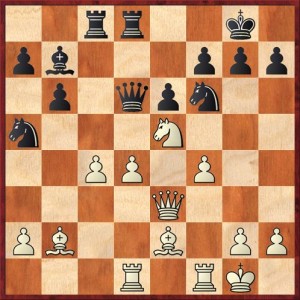
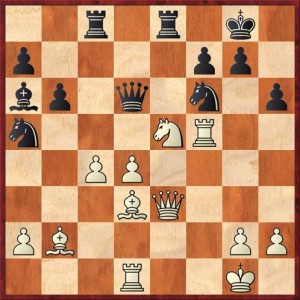
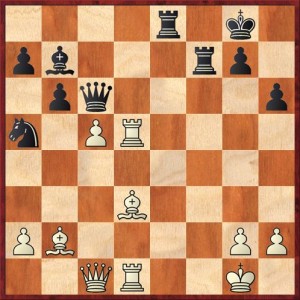
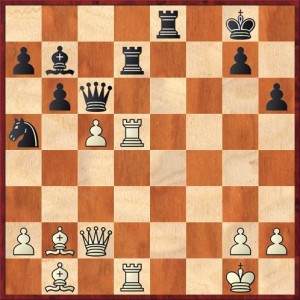
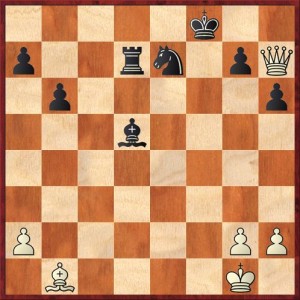



{ 2 comments… read them below or add one }
Thanks for the nice write-up Dana,
Did I really call Ivanov a patzer? If so I meant it as a joke.
In the position where you ended the analysis I played 17. Qd3? which allowed a fortress draw after 17…Ba2! 18. Qd7 Bb1 19. Qa7 Bf5 19. Qb6 Kf7.
Regarding the starting position, during the party I suggested Ivanov could have tried 1… Rc7 to double rooks so don’t blame Dana for that blunder in analysis. I played the game 24 years earlier and during my presentation was unable to remember some of the tactical points that I saw during the game.
The rook move to c7 would lose the queen to 2. Ba3.
{ 2 trackbacks }